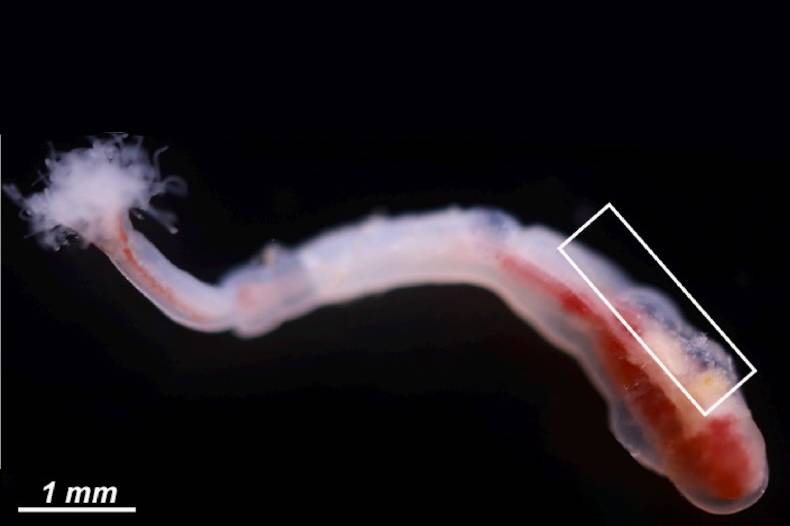Russian Scientists Have Studied Marine Worm with Unique Spermatozoa

Russian scientists at A.V. Zhirmunsky National Scientific Centre of Marine Biology, HSE University, and Moscow State University have studied Phoronis embryolabi, a rare species of marine invertebrate found in the waters of the Sea of Japan. This species is notable for its unique reproductive system, which includes the development of larvae within the parent’s body and an unusual sperm structure. The study's findings contribute to our understanding of the evolutionary adaptations of marine organisms to extreme conditions. The study has been published in Zoologischer Anzeiger.
Phoronis embryolabi is a small marine worm that is viviparous, meaning it gives birth to live young, with larvae developing inside the parent’s body. This is an important adaptation for Phoronis embryolabi, which lives as a commensal organism—a type of symbiotic relationship where the commensal benefits while the host remains unaffected—in the holes of burrowing shrimp. It has been discovered that the reproductive process in this species involves the formation of spermatozoa with an unusual structure.
Spermatozoa are filamentous cells capable of moving within the confined spaces of the body. They develop in vasoperitoneal tissue (VPT) that surrounds blood vessels. 'This structure enables spermatozoa to move efficiently through narrow spaces filled with cells and embryos,' according to Elena Temereva, Professor of the Joint Department with RAS Shemyakin-Ovchinnikov Institute of Bioorganic Chemistry, HSE Faculty of Biology and Biotechnology.
Unlike other phoronid species, whose spermatozoa are V-shaped, Phoronis embryolabi’s spermatozoa maintain an elongated shape throughout all stages of maturity. The flagellum, essential for movement, is closely aligned with the cell body, which aids in movement through the narrow spaces of the body cavity. This is important, because the numerous embryos and other cells developing inside the body create additional challenges for sperm movement.
Sperm cells in Phoronis embryolabi, known as introsperm, possess unique adaptations typical of species with internal fertilisation. To reach the eggs, they must navigate through dense layers of cells and squeeze in the narrow spaces within the body. The researchers found that these spermatozoa are equipped with a collar around the base of the flagellum, which, along with undulating movements, enables them to move through the densely packed inner spaces of the animal. This movement resembles that of certain single-cell parasites, such as trypanosomes, which use similar mechanisms to move through a viscous medium.
For comparison, in other phoronid species, such as Phoronis pallida and Phoronopsis harmeri, introsperm are V-shaped cells composed of two parts: one part is the flagellum, while the other contains the nucleus and mitochondria. In Phoronis embryolabi, all components of the sperm are closely interconnected, which enhances their ability to move efficiently through narrow spaces. In addition, their spermatozoa are shorter than those of other species, which may also be an adaptation to the habitat conditions.
The study of spermatogenesis and sperm structure in Phoronis embryolabi provides valuable insights into how organisms adapt to extreme conditions. This information helps deepen our understanding of the evolution of reproductive biology in marine invertebrates and the factors that have influenced the development of complex reproductive strategies.
The unique adaptations of spermatozoa in Phoronis embryolabi are a crucial component of this species' survival strategy. The ability to move through narrow spaces and fertilise eggs in a body filled with embryos and other cells is an example of a successful evolutionary adaptation.
The research was carried out with support from the Russian Science Foundation.
See also:
Script Differences Hinder Language Switching in Bilinguals
Researchers at the HSE Centre for Language and Brain used eye-tracking to examine how bilinguals switch between languages in response to context shifts. Script differences were found to slow down this process. When letters appear unfamiliar—such as the Latin alphabet in a Russian-language text—the brain does not immediately switch to the other language, even when the person is aware they are in a bilingual setting. The article has been published in Bilingualism: Language and Cognition.
HSE Experts Highlight Factors Influencing EV Market Growth
According to estimates from HSE University, Moscow leads in the number of charging stations for electric vehicles in Russia, while Nizhny Novgorod ranks first in terms of charging station coverage, with 11.23 electric vehicles per charging station, compared to 14.41 in Moscow. The lack of charging infrastructure is one of the key factors limiting the growth of the electric vehicle market. This is stated in the study titled ‘Socio-Economic Aspects of Introducing Electric Vehicles in Commercial Transportation’ conducted by experts from the Institute of Transport Economics and Transport Policy Studies at HSE University.
Machine Learning Links Two New Genes to Ischemic Stroke
A team of scientists from HSE University and the Kurchatov Institute used machine learning methods to investigate genetic predisposition to stroke. Their analysis of the genomes of over 5,000 people identified 131 genes linked to the risk of ischemic stroke. For two of these genes, the association was found for the first time. The paper has been published in PeerJ Computer Science.
First Digital Adult Reading Test Available on RuStore
HSE University's Centre for Language and Brain has developed the first standardised tool for assessing Russian reading skills in adults—the LexiMetr-A test. The test is now available digitally on the RuStore platform. This application allows for a quick and effective diagnosis of reading disorders, including dyslexia, in people aged 18 and older.
Low-Carbon Exports Reduce CO2 Emissions
Researchers at the HSE Faculty of Economic Sciences and the Federal Research Centre of Coal and Coal Chemistry have found that exporting low-carbon goods contributes to a better environment in Russian regions and helps them reduce greenhouse gas emissions. The study results have been published in R-Economy.
Russian Scientists Assess Dangers of Internal Waves During Underwater Volcanic Eruptions
Mathematicians at HSE University in Nizhny Novgorod and the A.V. Gaponov-Grekhov Institute of Applied Physics of the Russian Academy of Sciences studied internal waves generated in the ocean after the explosive eruption of an underwater volcano. The researchers calculated how the waves vary depending on ocean depth and the radius of the explosion source. It turns out that the strongest wave in the first group does not arrive immediately, but after a significant delay. This data can help predict the consequences of eruptions and enable advance preparation for potential threats. The article has been published in Natural Hazards. The research was carried out with support from the Russian Science Foundation (link in Russian).
Centre for Language and Brain Begins Cooperation with Academy of Sciences of Sakha Republic
HSE University's Centre for Language and Brain and the Academy of Sciences of the Republic of Sakha (Yakutia) have signed a partnership agreement, opening up new opportunities for research on the region's understudied languages and bilingualism. Thanks to modern methods, such as eye tracking and neuroimaging, scientists will be able to answer questions about how bilingualism works at the brain level.
How the Brain Responds to Prices: Scientists Discover Neural Marker for Price Perception
Russian scientists have discovered how the brain makes purchasing decisions. Using electroencephalography (EEG) and magnetoencephalography (MEG), researchers found that the brain responds almost instantly when a product's price deviates from expectations. This response engages brain regions involved in evaluating rewards and learning from past decisions. Thus, perceiving a product's value is not merely a conscious choice but also a function of automatic cognitive mechanisms. The results have been published in Frontiers in Human Neuroscience.
AI Predicts Behaviour of Quantum Systems
Scientists from HSE University, in collaboration with researchers from the University of Southern California, have developed an algorithm that rapidly and accurately predicts the behaviour of quantum systems, from quantum computers to solar panels. This methodology enabled the simulation of processes in the MoS₂ semiconductor and revealed that the movement of charged particles is influenced not only by the number of defects but also by their location. These defects can either slow down or accelerate charge transport, leading to effects that were previously difficult to account for with standard methods. The study has been published in Proceedings of the National Academy of Sciences (PNAS).
Electrical Brain Stimulation Helps Memorise New Words
A team of researchers at HSE University, in collaboration with scientists from Russian and foreign universities, has investigated the impact of electrical brain stimulation on learning new words. The experiment shows that direct current stimulation of language centres—Broca's and Wernicke's areas—can improve and speed up the memorisation of new words. The findings have been published in Neurobiology of Learning and Memory.



